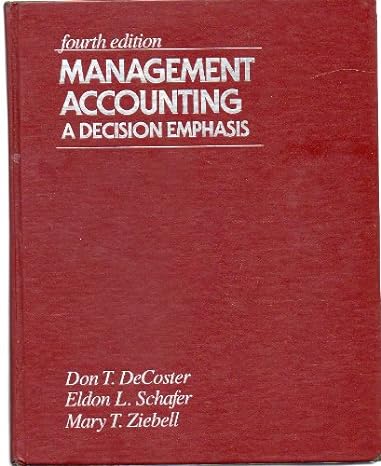Answered step by step
Verified Expert Solution
Question
1 Approved Answer
Comparing Inventory Costing Methods using Excel's Basic Math Functions and Cell References Better Bottles, Inc. uses a periodic inventory system and has provided its current
Comparing Inventory Costing Methods using Excel's Basic Math Functions and Cell References Better Bottles, Inc. uses a periodic inventory system and has provided its current inventory information. The Controller has as you to prepare a comparison of the Ending Inventory and Cost of Goods Sold totals for three different inventory costing methods: Periodic FIFO, LIFO, and Weighted-Average. Use the information included in the Excel Simulation and the Excel functions described below to complete the task. Cell Reference: Allows you to refer to data from another cell in the worksheet. From the Excel Simulation below, if in a blank cell, "85" was entered, the formula would output the result from cell 85, or 27 in this example. Basic Math functions: Allows you to use the basic math symbols to perform mathematical functions. You can use the following keys: +(plus sign to add),- (minus sign to subtract), (asterisk sign to multiply), and/ (forward slash to divide). From the Excel Simulation below, if in a blank cell "-84+85" was entered, the formula would add the values from those cells and output the result, or 47 in this example. If using the other math symbols the result would output an appropriate answer for its function. SUM function: Allows you to refer to multiple cells and adds all the values. You can add individual cell references or ranges to utilize this function. From the Excel Simulation below, if in a blank cell =SUM(C4,C5, C6)" was entered, the formula would output the result of adding those three separate cells, or $72.00 in this example. Similarly, if in a blank cell "=SUM(C4:C6)" was entered, the formula would output the same result of adding those cells, except they are expressed as a range in the formula, and the result would be $72.00 in this example. Inventory costing methods - Excel ? E FILE HOME INSERT PAGE LAYOUT FORMULAS DATA REVIEW VIEW Sign In Calbri 11 % Paste BIU- Clipboard Font Styles x e Alignment Number Conditional Format as Cell Cells Editing Formatting Table Styles Better Bottles, Inc., uses a periodic inventory system and has the following B D 1 Better Bottles, Inc., uses a periodic inventory system and has the following information available: 123 Description E 4 Beginning Inventory 5 Jan. 15 Purchase 6 Jan. 20 Purchase 7 Goods Available for Sale 8 Less: January Sales # of Units Cost per Unit Total Cost 20 $ 20.00 $ 400.00 27 22.00 594.00 33 30.00 990.00 80 S 1,984.00 36 44 9 Ending Inventory 10 11 12 Required: 131) Calculate both the Ending Inventory and Cost of Goods Sold using Periodic FIFO. F Inventory costing methods - Excel FILE HOME INSERT PAGE LAYOUT FORMULAS DATA REVIEW VIEW 86 Calibri 11 AA % Paste BIU- Clipboard Font 19 1 3 E Alignment Number Conditional Format as Cell Formatting Table Styles Styles fx Better Bottles, Inc., uses a periodic inventory system and has the following 5 x Sign In M Cells Editing A B C D E F 12 Required: 131) Calculate both the Ending Inventory and Cost of Goods Sold using Periodic FIFO. 14 15 16 Description: 17 Jan. 20 Purchase FIFO Ending Inventory # of Units Cost per Unit Total Cost 18 Jan. 15 Purchase 19 20 21 22 Description 44 FIFO Cost of Goods Sold # of Units Cost per Unit Total Cost 23 Beginning Inventory 24 Jan. 15 Purchase 25 26 36 27 2) Calculate both the Ending Inventory and Cost of Goods Sold using Periodic LIFO. 28 29 30 Description LIFO Ending Inventory # of Units Cost per Unit Total Cost 31 Beginning Inventory 32 Jan. 15 Purchase 33 34 Sheet1 44 d Inventory costing methods Excel 5 x Sign In HOME INSERT PAGE LAYOUT FORMULAS DATA REVIEW VIEW Calibri BIU A Font X 11 . A A % 4 A Alignment Number G Conditional Format as Cell Formatting Table Styles- Styles Cells Editing Better Bottles, Inc., uses a periodic inventory system and has the following B D E Description .20 Purchase 15 Purchase LIFO Cost of Goods Sold # of Units 36 Cost per Unit Total Cost Using Periodic Weighted Average, first calculate the cost per unit using the formula below. xt, apply that same cost per unit to calculate both the Ending Inventory and Cost of Goods Sold. Weighted Average Cost= Cost of Goods Available for Sale Number of Units Available for Sale = F per unit Total Cost Weighted Average Ending Inventory Cost per Unit # of Units Weighted Average Cost of Goods Sold # of Units Cost per Unit Total Cost Use the given information and your calculated numbers to complete the Cost of Goods Sold austion helow for all three inventory methode (All numhere should he nocitive) DY mpt(s) Sheet1 4 +100% 56 4) Use the given information and your calculated numbers to complete the Cost of Goods Sold 57 Equation below for all three inventory methods. (All numbers should be positive.) 58 59 Beginning Inventory FIFO LIFO Wtd. Avg. 60 Add: Purchases 61 Goods Available for Sale 62 Less: Ending Inventory 63 Cost of Goods Sold 64 65 66 67
Step by Step Solution
There are 3 Steps involved in it
Step: 1

Get Instant Access to Expert-Tailored Solutions
See step-by-step solutions with expert insights and AI powered tools for academic success
Step: 2

Step: 3

Ace Your Homework with AI
Get the answers you need in no time with our AI-driven, step-by-step assistance
Get Started


